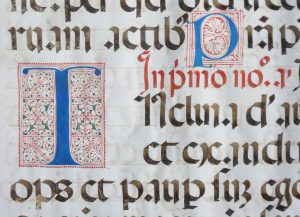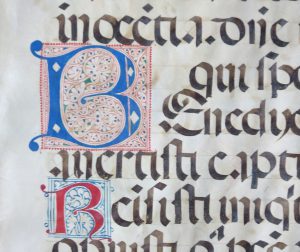Two Vellum Leaves from a Large-Format Latin Breviary in Gothic Script
October 2, 2021 in Manuscript Studies

Private Collection, MS 1, Fol. 1 (‘137’)r, Initial I (for Inclina). Photography Mildred Budny. Reproduced by permission.
A Pair of Non-Consecutive Leaves
from a Large-Format
Latin Breviary
in Gothic Script on Vellum
Circa 590 mm × 447 mm
< written area circa 397 × 307 mm>
Single column of 15 lines
in Gothic Script
with rubrications, embellished initials,
and reiterated medieval and modern ‘folio’ numbers
Folio 1 (‘130’)
Vulgate Psalms (Septuagint Translation) 83:11 – 84:12 (Veri-[tas])
and
Folio 2 (‘137’)
Within Friday Matins:
Hymn Tu Trinitatis Unitas ([ . . . Ne corpus /] assit sordidum . . . Pater piissime)
Antiphon Inclina Domine, and Psalm 86 1:1–12 (Con-[fitebor])
14th or 15th Century, perhaps Italian or Spanish

Private Collection, MS 1, Fol. 130r, initials B and R. Photography Mildred Budny. Reproduced by permission.
Continuing to examine manuscripts and fragments in our blog on Manuscript Studies (see its Contents List), we turn to a pair of large, single leaves which arrived in a Private Collection several years ago, as a gift from another Private Collection. About this pair of leaves, we might exclaim: What beauties!
For the current owner, with an interest in manuscript studies, especially medieval manuscripts, these leaves comprise the first in the library (mostly printed books about books). Hence the assigned number, “MS 1”, with two detached leaves (Folios ‘1’ and ‘2’ in the set) from the same original manuscript.
The identity and origin of that manuscript remain, for now, unknown. Perhaps this blogpost, presenting the detached leaves to wider view through their photographs and related information, might bring to light more information about them and their travels across time and place.
The pair came on their own, safely packaged with mats in a large shipping box, but without any accompanying information. That is, apart from the former owner’s recollection relayed in conversation and email.
These two large leaves would have come as a purchase some years ago, in the late 1980s or early 1990s, at the New York Antiquarian Book Fair, a repeated venue for some other purchases for the same collection.
“The two large ones are German and quite late, if I remember rightly. I bought them from a German dealer at the NY Antiquarian Book Fair. No, I don’t recall his name. It was a looong [sic] time ago. I suspect the two smaller ones [= MS 2, in another shipping] were purchased at the same venue, though different dealer.”
On their own, the two leaves must or can speak for itself. We bring to the table the willingness to examine them closely, to admire their resonant beauty, and to see what they can say. Their story resides not only in the text, which can be deciphered, abbreviations and all, but also in the features of layout, script, decoration, rubrications, annotations, the animal skins for the writing surfaces, the traces of a former binding, and other forms of material evidence.
